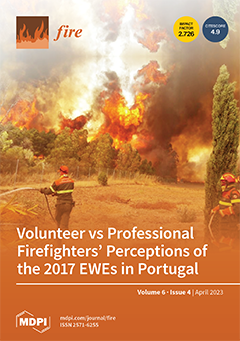Fire, Volume 6, Issue 4 (April 2023) – 45 articles
Firefighters express their opinions concerning operational experience facing fire, difficulties and weaknesses, emotions, lessons learned, and new strategies of management. Although with some differences in perceptions, Extreme Wildfire Events’ complexity and challenges are not yet well understood by firefighters still using techniques and approaches no longer adequate to cope with EWEs characteristics, but asking for more resources to reinforce suppression. View this paper
- Issues are regarded as officially published after their release is announced to the table of contents alert mailing list.
- You may sign up for e-mail alerts to receive table of contents of newly released issues.
- PDF is the official format for papers published in both, html and pdf forms. To view the papers in pdf format, click on the "PDF Full-text" link, and use the free Adobe Reader to open them.





